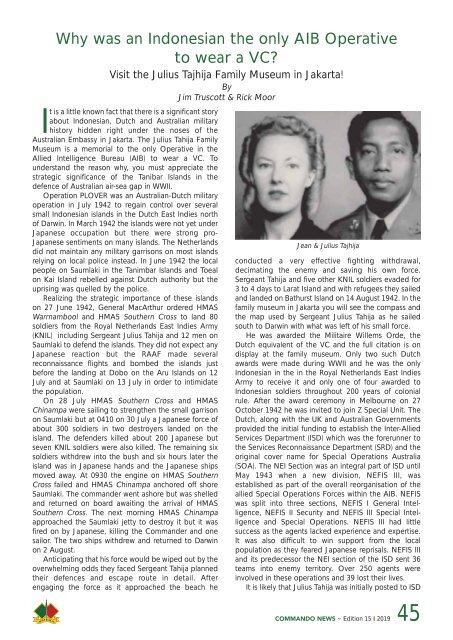Commando News issue 15 2019
The Official Australian Commando News Magazine
The Official Australian Commando News Magazine
You also want an ePaper? Increase the reach of your titles
YUMPU automatically turns print PDFs into web optimized ePapers that Google loves.
Why was an Indonesian the only AIB Operative<br />
to wear a VC?<br />
Visit the Julius Tajhija Family Museum in Jakarta!<br />
By<br />
Jim Truscott & Rick Moor<br />
It is a little known fact that there is a significant story<br />
about Indonesian, Dutch and Australian military<br />
history hidden right under the noses of the<br />
Australian Embassy in Jakarta. The Julius Tahija Family<br />
Museum is a memorial to the only Operative in the<br />
Allied Intelligence Bureau (AIB) to wear a VC. To<br />
understand the reason why, you must appreciate the<br />
strategic significance of the Tanibar Islands in the<br />
defence of Australian air-sea gap in WWII.<br />
Operation PLOVER was an Australian-Dutch military<br />
operation in July 1942 to regain control over several<br />
small Indonesian islands in the Dutch East Indies north<br />
of Darwin. In March 1942 the islands were not yet under<br />
Japanese occupation but there were strong pro-<br />
Japanese sentiments on many islands. The Nether lands<br />
did not maintain any military garrisons on most islands<br />
relying on local police instead. In June 1942 the local<br />
people on Saumlaki in the Tanimbar Islands and Toeal<br />
on Kai Island rebelled against Dutch authority but the<br />
uprising was quelled by the police.<br />
Realizing the strategic importance of these islands<br />
on 27 June 1942, General MacArthur ordered HMAS<br />
Warrnambool and HMAS Southern Cross to land 80<br />
soldiers from the Royal Netherlands East Indies Army<br />
(KNIL) including Sergeant Julius Tahija and 12 men on<br />
Saumlaki to defend the islands. They did not expect any<br />
Japanese reaction but the RAAF made several<br />
reconnaissance flights and bombed the islands just<br />
before the landing at Dobo on the Aru Islands on 12<br />
July and at Saumlaki on 13 July in order to intimidate<br />
the population.<br />
On 28 July HMAS Southern Cross and HMAS<br />
Chinampa were sailing to strengthen the small garrison<br />
on Saumlaki but at 0410 on 30 July a Japanese force of<br />
about 300 soldiers in two destroyers landed on the<br />
island. The defenders killed about 200 Japanese but<br />
seven KNIL soldiers were also killed. The remaining six<br />
soldiers withdrew into the bush and six hours later the<br />
island was in Japanese hands and the Japanese ships<br />
moved away. At 0930 the engine on HMAS Southern<br />
Cross failed and HMAS Chinampa anchored off shore<br />
Saumlaki. The commander went ashore but was shelled<br />
and returned on board awaiting the arrival of HMAS<br />
Southern Cross. The next morning HMAS Chinampa<br />
approached the Saumlaki jetty to destroy it but it was<br />
fired on by Japanese, killing the Commander and one<br />
sailor. The two ships withdrew and returned to Darwin<br />
on 2 August.<br />
Anticipating that his force would be wiped out by the<br />
overwhelming odds they faced Sergeant Tahija planned<br />
their defences and escape route in detail. After<br />
engaging the force as it approached the beach he<br />
Jean & Julius Tajhija<br />
conducted a very effective fighting withdrawal,<br />
decimating the enemy and saving his own force.<br />
Sergeant Tahija and five other KNIL soldiers evaded for<br />
3 to 4 days to Larat Island and with refugees they sailed<br />
and landed on Bathurst Island on 14 August 1942. In the<br />
family museum in Jakarta you will see the compass and<br />
the map used by Sergeant Julius Tahija as he sailed<br />
south to Darwin with what was left of his small force.<br />
He was awarded the Militaire Willems Orde, the<br />
Dutch equivalent of the VC and the full citation is on<br />
display at the family museum. Only two such Dutch<br />
awards were made during WWII and he was the only<br />
Indonesian in the in the Royal Netherlands East Indies<br />
Army to receive it and only one of four awarded to<br />
Indonesian soldiers throughout 200 years of colonial<br />
rule. After the award ceremony in Melbourne on 27<br />
October 1942 he was invited to join Z Special Unit. The<br />
Dutch, along with the UK and Australian Governments<br />
provided the initial funding to establish the Inter-Allied<br />
Services Department (ISD) which was the forerunner to<br />
the Services Reconnaissance Department (SRD) and the<br />
original cover name for Special Operations Australia<br />
(SOA). The NEI Section was an integral part of ISD until<br />
May 1943 when a new division, NEFIS III, was<br />
established as part of the overall reorganisation of the<br />
allied Special Operations Forces within the AIB. NEFIS<br />
was split into three sections, NEFIS I General Intel -<br />
ligence, NEFIS II Security and NEFIS III Special Intel -<br />
ligence and Special Operations. NEFIS III had little<br />
success as the agents lacked experience and expertise.<br />
It was also difficult to win support from the local<br />
population as they feared Japanese reprisals. NEFIS III<br />
and its predecessor the NEI section of the ISD sent 36<br />
teams into enemy territory. Over 250 agents were<br />
involved in these operations and 39 lost their lives.<br />
It is likely that Julius Tahija was initially posted to ISD<br />
COMMANDO NEWS ~ Edition <strong>15</strong> I <strong>2019</strong> 45

















